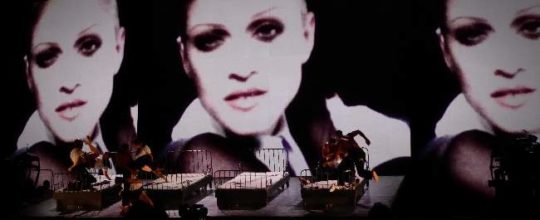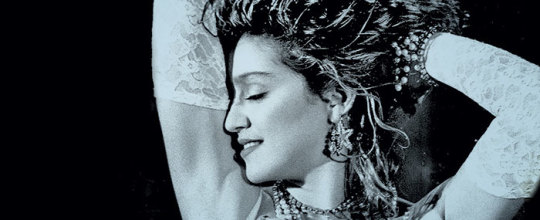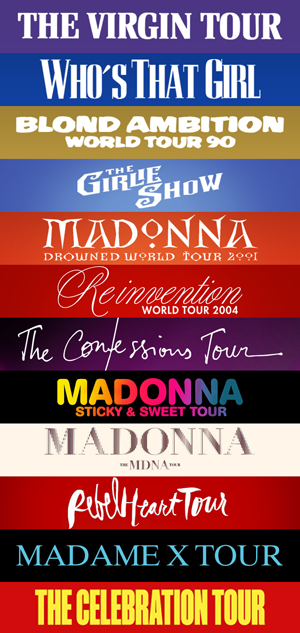“Ray of Light predicted our obsession with celebrity”
Sophie Wilkinson on Vice discusses how Ray of Light became Madonna‘s second most successful studio album, which, twenty years on, still sounds spectacular.
In the days following Princess Diana’s death in 1997, the other most famous blonde in the world (Madonna) made a plea at the MTV Music Video Awards, not to the paparazzi or media, but to the public. She questioned our appetite for gossip and scandal, imploring us all to no longer “live vicariously through other people’s misery” before declaring: “it’s time that we realise that everything that we say and do has an effect on the world around us, that we are all connected, and we are all one.”
A few months later, she would release Ray of Light, a vicious rejection of celebrity and a powerful, if not problematic, attempt at declaring all peoples part of a glorious, unifying humanity. It also brimmed with love, just not the romantic kind, and would become her second most successful studio album, which, twenty years on, still sounds spectacular.
By 1996, Madonna was in a position to take risks. Fresh off of an Oscar-winning turn in Evita (for the Andrew Lloyd Webber and Tim Rice song), her own musical career was at an ebb. Despite the hype of the corollary release of the SEX book, and a fabricated rivalry with that other young Catholic rebel Sinead O’Connor, Erotica sold just five million copies. Bedtime Stories skimmed three million.
Madonna decided to can recording sessions with Babyface – who’d helped deliver the latter’s naff R&B posturing – and instead took her Patrick Leonard co-writes to William Orbit, a former crusty who made the sort of breakbeat-techno people still listen to in Bristol. Combined with a voice that had deepened — and smoothed — with age, the output was euphoric and eclectic, exactly what Madonna had aimed for: “I was interested in fusing a kind of futuristic sound, but also using lots of Indian and Moroccan influences and things like that… I wanted it to sound old and new at the same time”.
Alongside Orbit’s recognisable bleeps and bloops, the twangs of sitars tinge Skin, and Shanti/Ashtangi is a poorly-pronounced rendition of the Yoga Taravli chants, interspersed with Bollywood samples. Promotional images and performances of Ray of Light have aged even less flatteringly — we saw Madonna in geisha gear, and saris, and her MTV VMA rendition of Ray of Light, the single, was condemned by a Hindu group upset by her sexualisation of sacred imagery. That said, after Madonna rebutted the Hindu group with a “if they’re so religious, why are they watching MTV?” they recognised her efforts in publicising their religion.
Madonna had risen to prominence by chipping away at her own Catholicism (in Like a Virgin and Like a Prayer), but she also undoubtedly treated different cultures as aesthetic elements to pick and choose from. There was much that was, is, problematic with this album: rather than work with a producer sampling the sounds she was inspired by, the gaps in her knowledge could have been bridged by a Graceland-style collaboration with musicians from the places she sought influence from.
But she was loud, brash, booby Madonna, not everyman Paul Simon. In a 1999 interview with Larry King, she complained that her fame clouded her view of so much: “Sometimes you wanna go for a walk… and you just wanna be anonymous and blend in, especially when you travel, because I can’t really go out and see a city the way other people can and I miss out on a lot.” The gilded cage of her worldwide fame – and, in some cases, notoriety – had long restricted her ability to learn and collaborate authentically. She added: “The worst thing about being famous, I think it’s what everybody says, the lack of privacy and the idea that you’re not really allowed to make mistakes and everything that you do is viewed under a microscope.”
Celebrity had long been Madonna’s closest ally. She played up her relationships – and even pretend relationships – to cameras, sold her most intimate parts in the SEX book and used both Material Girl and Vogue to pay homage to, and imitate the glamour of, Hollywood’s golden age. But with close friend Gianni Versace and Diana’s deaths came a stark warning of the excesses of celebrity. Not the vices that befall our brightest stars – an avid dancer and control-freak, Madonna has never been one for too much of any substance – but how people destroy their idols, willingly or not. Ray of Light is Madonna breaking up with celebrity. To the whistle of a cold wind, opener Drowned World/Substitute for Love Madonna intones: “I traded fame for love/Without a second thought/It all became a silly game/Some things cannot be bought.” And after a percussion-heavy techno-influenced middle 8, she pronounces sincerely “Now, I find/I’ve changed my mind. This is my religion.”
In this ethereal light, you might wonder what her religion really is. Ray of Light’s first single, the Middle-Eastern stringed Frozen has her condemn both materialism: “You’re so consumed with how much you get”, and stoicism: “You’re frozen/ When your heart’s not open”. Similarly, The Power of Good-bye reaches out to a closed lover: “Your heart is not open so I must go” and she longs to untether herself from earthly possessions: “Learn to say good-bye/I yearn to say goodbye”. Meanwhile, Candy Perfume Girl was such nonsense in the vein of The Beatles’ Strawberry Fields that the manufacturers of Magnetic Poetry accused Madonna of using their Christmas-stocking filler of a gift to construct its babble. She denied this.
Kabbalah wristbands and yoga flexes aside, the simplest and most coherent signifier of Madonna’s new religion is in Nothing Really Matters, where she condenses the Buddhist sentiment of life and death’s interminable cycle into the banging refrain: “Nothing really matters/Love is all we need/Everything I give you/All comes back to me.” Not only is it vague enough to be universally relatable, but literally read, it’s about the umbilical unity of a mother and child.







